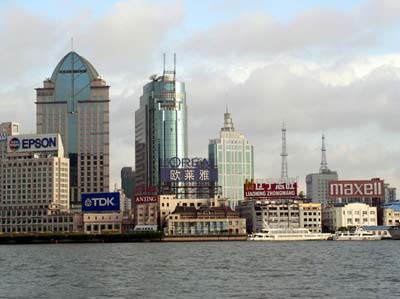China closes foreign investment gap
( 2003-08-26 10:05) (Agencies)
The dramatic impact of globalisation on the world's economic interdependence is demonstrated in new figures on foreign direct investment released on Monday by the United Nations Conference on Trade and Development ahead of its annual world investment report next week.

The picture shows advertisement boards promoting multinationals along the riverside bund overlooking the Pudong financial district in Shanghai. [newsphoto.com.cn] |
The global stock of FDI jumped more than tenfold between 1980 and 2002 to $7,100bn, as transnational companies spread their production and distribution systems around the world.
The figures showed Chinese mainland rapidly catching up with the US as the world's most popular location for foreign investment. The US tops the league table of overseas investment destinations with a stock of FDI of US$1,351 billion. But the stock in Chinese mainland totalled US$448 billion, up from just US$25 billion in 1990. Combined with Hong Kong's stock of FDI of US$433 billion, China takes the number two spot.
A combination of cheap labour and robust domestic growth helped Chinese mainland attracted a record US$52.7 billion in FDI last year - more than any other country. By contrast, net FDI inflows into the US have stagnated in recent years. Last year there was a net outflow of US$98 billion.
FDI flows have fallen sharply in the past two years and appear to be set for a further decline in 2003. But stock changes take place far more slowly.
The figures also underlined the growing importance of overseas investment in developing countries. FDI stocks in developing countries represented about a third of their gross domestic product in 2002, compared with just 13 per cent in 1980. For industrialised countries, which host two-thirds of the world's inward FDI, stocks of foreign investment now account for a fifth of GDP on average from just 5 per cent in 1980.
Brazil has been the largest recipient of FDI capital in the developing world aside from China, with its stock of FDI jumping from US$37 billion to US$236 billion. Mexico, which has benefited from strong investment inflows from the US, ranked 13th in the global league table. Its accumulated FDI totalled US$154 billion last year, up from US$22 billion in 1990.
Meanwhile, inflows into Eastern Europe have been relatively unspectacular. Eastern European countries increased their stock of FDI from US$3 billion in 1990 to US$188 billion in 2002. But this was only slightly larger than the accumulated investment in Ireland.
Not a single Eastern European country was in the top 20 investment locations, with Poland the highest ranking at 27.
The figures show that foreign investment remains very unequally distributed, with the top 10 hosts accounting for two-thirds of total inward FDI stocks. The 49 poorest countries accounted for just 2 per cent of the inward FDI stock in 2002, a share that has changed little in recent years.
|